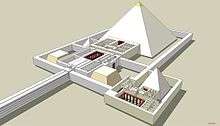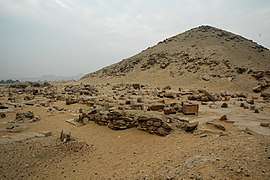Pyramid of Djedkare Isesi
| Djedkare's Pyramid Sentinel Pyramid (Arabic: هَــرَم الـشَّـوَّاف, translit. Haram ash-Shawwāf)[1] | |||||||||||||
|---|---|---|---|---|---|---|---|---|---|---|---|---|---|
 Djedkare's pyramid in the 1990s | |||||||||||||
| Djedkare Isesi | |||||||||||||
| Coordinates | 29°51′04″N 31°13′15″E / 29.85111°N 31.22083°ECoordinates: 29°51′04″N 31°13′15″E / 29.85111°N 31.22083°E | ||||||||||||
| Ancient name |
Nfr-Djed-kʒ-Rˁ Nefer-Djed-ka-Re Beautiful is Djedkare Isesi[2] | ||||||||||||
| Constructed | 5th Dynasty | ||||||||||||
| Type | True pyramid (ruined) | ||||||||||||
| Height | 100 cubits (52.5 m (172 ft)) | ||||||||||||
| Base | 150 cubits (78.60 metres (257.9 feet)) | ||||||||||||
| Slope | 52° | ||||||||||||
The Ancient Egyptian pyramid of Pharaoh Djedkare Isesi[3] was built at South Saqqara in the fifth dynasty. The translation of its ancient Egyptian name is "Beautiful is Djedkare". The pyramid was the first one to be built south of the main Saqqara necropolis. Today, it is located in Egypt's Giza Governorate,[1][4][5] and the haram (Arabic: هَـرم, pyramid)[6] is referred to as El-Shawaf (Arabic: اَلــشَّــوَّاف, translit. Ash-Shawwāf, lit. 'The Sentinel')[1] by the locals.[7]
Construction


The ḥaram (Arabic: حَـرم, complex)[8] includes the main pyramid, a satellite pyramid and an associated pyramid which is probably that of his unnamed consort, and is hence known as The Pyramid of the Unknown Queen.[7]
The core of the pyramid was composed of six steps of irregularly shaped limestone blocks.[3] Its original height was around 52 m (171 ft). The angle of inclination was 52°, and it has a base length of 78.75 metres (258.4 feet).[6]
Despite extensive counter measures which included three huge portcullis slabs, plunderers were still able to penetrate to the burial chamber.[3]
Modern excavation
The pyramid was first explored in 1880 by Gaston Maspero. In the 1940s the pyramid was excavated by Abdel-Salam Hussein (his work on the site was never published).[3]
Upon the entrance of the burial chamber, a smashed dark grey basalt sarcophagus was discovered, a mummy estimated to belong to a fifty-year-old man was found amongst the debris. This discovery indicated that Djedkare-Isesi must have been very young when he ascended the throne given his reign, which exceeded 32 years.[3]
- Palmiform column from the pyramid complex
 The pyramid and mortuary temple east of it
The pyramid and mortuary temple east of it
See also
References
- 1 2 3 "هرم الشواف". Geoview.info (in en + ar). ISBN 978-0-8021-3935-1. Retrieved 2018-04-15.
- ↑ Verner 2001a, p. 324.
- 1 2 3 4 5 "Pyramid & Mortuary Complex of Djedkare-Isesi".
- ↑ "عالم آثار ينفي المعلومات المغلوطة المنسوبة للملك 'جد كارع اسيسي'". Masress.com (in Arabic). 2014-03-06. Retrieved 2018-04-15.
- ↑ "عالم مصريات يصحح معلومات "حواس" حول "اسيسي".. ويكشف: الملك متزوج من الملكة "مرسي ــ عنخ"". Elwatannews.com (in Arabic). 2014-03-06. Retrieved 2018-04-15.
- 1 2 Lehner, Mark (1997), The Complete Pyramids, London: Thames & Hudson Ltd., p. 53, ISBN 0-500-05084-8
- 1 2 Verner, M. (2001) [1997]. "The Pyramids: The Mystery, Culture, and Science of Egypt's Great Monuments". Grove Press. pp. 324–332. ISBN 978-0-8021-3935-1.
- ↑ "The Pyramid of Dejedkare-Isesi". egyptphoto.ncf.ca. Retrieved 2018-02-26.
External links
| Wikimedia Commons has media related to Pyramid of Djedkare Isesi. |